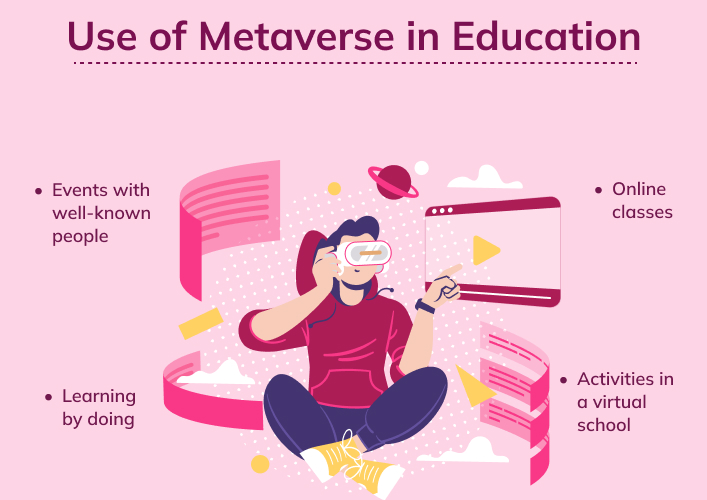Use of Metaverse in Education

The metaverse has a huge number of uses in schooling. The education field is about to take a big step forward as it changes from eLearning to metaverse. Here are some of the uses of metaverse development in edtech.
- Learning by doing – With the metaverse, you can better understand ideas from different fields by mixing them. For instance, math methods can be used to help understand physics ideas better, so that students can learn everything at once.
- Online classes – eLearning makes learning possible at any time and in any place. However, the benefits of real classes can’t be replaced or copied in an online learning setting. Metaverse, a virtual 3D school, is the only thing that can bridge the gap between real and virtual classes. The students can make their own virtual characters, or ‘avatars’, and they can go to class with other students in a virtual 3D world. The metaverse also gives people many ways to learn by doing.
- Events with well-known people – It can be very helpful to bring in famous people like scientists, doctors, and athletes and have the students connect with them and learn from their experiences and knowledge. In the metaverse, places can be set up for virtual workshops, gatherings, and classes.
- Activities in a virtual school – In the virtual classroom, students can do things like go to class with other students and take part in games, sports, educational clubs, and many other events and activities. It gives you the impression that you are really on campus and taking part in events.
Benefits of Metaverse in Edutech
- It is much easier to understand an idea when it is presented in a virtual setting where you can interact with it. For example, it will be much easier to get a general knowledge of the solar ecosystem if you can virtually walk through the galaxy and see where the planets are and how they move around it. Medical surgeries and astrophysics studies are two examples of jobs that need practice to get good at them. When schooling meets the metaverse, these jobs are easy to do.
- The metaverse can help students focus on what they are learning. Giving pupils badges and other forms of praise keeps them encouraged and helps them stay on task to finish the tasks they’ve been given. For example, students can travel to different parts of the world in the metaverse to learn about their traits and environments and win badges. The students can then make models based on the culture of the place they want to visit and then design the area they want to visit.
- With methods that work with the internet, it’s easy to share knowledge with more people. After they are made, courses can be used by many students, which saves time and money. Better publicly shared tools and personalized search results will make it easy to understand how to create a personalized learning path.
Features of Metaverse in Education
- In virtual areas, students can work together with teachers and other students. Teachers can help them learn how to communicate and work as a team. Working together on projects and activities is a fun and interesting feature of the metaverse in education.
- Individualized learning is possible in the metaverse, where material and tasks can be changed to fit the needs and interests of each student. This ability to change can help students learn better and move forward at their own pace.
- The metaverse gives people from all over the world access to a huge number of training materials. Students can improve their knowledge by visiting virtual museums, libraries, and other educational institutions without leaving their homes.
- It is possible to make virtual meetings more available and open to students with disabilities. Closed subtitles, text-to-speech, and characters that can be changed can help students with a wide range of learning needs.
Conclusion
There is a bright future for education in the metaverse. Its many benefits will change how students learn and how teachers teach. Immersive learning, personalized education, worldwide connection, teamwork, and accessibility are some of the main benefits. As technology keeps getting better, the metaverse could change the way we learn by making it more fun, useful, and open to everyone. But it also brings up problems that need to be fixed when it comes to privacy, security, and digital fairness. The metaverse in education could make learning settings that are more dynamic and engaging, meeting the needs of both students and teachers, but only if it is carefully planned and developed.
FAQs
What is the metaverse in education?
What are the advantages of using the metaverse in education?
Are there any disadvantages or challenges with metaverse-based education?
How can educators and students benefit from the metaverse in edtech?
Is the metaverse in edtech the future of learning?
Ravi Bhojani is the Chief Marketing Officer (CMO) at Alian Software, where he spearheads the company’s marketing strategies and drives its brand presence in the competitive IT services landscape. With over a decade of experience in the technology and marketing sectors, Ravi has consistently demonstrated his ability to blend innovative marketing techniques with deep industry knowledge to deliver outstanding results.